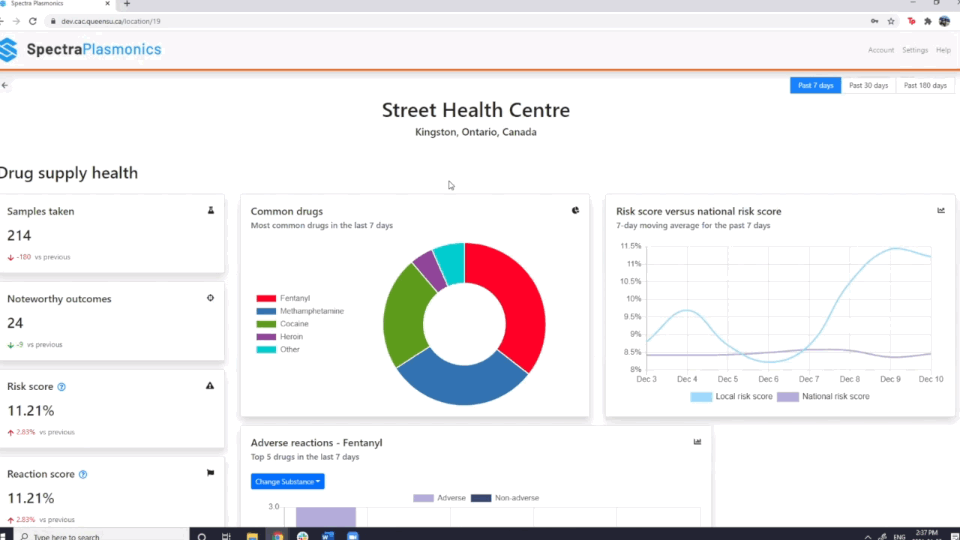The Amplifi ID™ Advantage
Experience the power of precision in 3 effortless steps
Dilute
Dilute the drug sample to prepare it for analysis.
1
Shoot
Effortlessly scan the prepared sample with the Amplifi ID Reader.
2
Analyze
Our software analyzes the signal and provides plain language results.
3
Within just 10 minutes, assess the composition of the drug sample and gain valuable insights.
How it works: Enhanced Molecular Fingerprinting
Proprietary Sensing Platform
Amplifi ID leverages the power of portable Raman spectroscopy and surface enhanced Raman scattering (SERS) to detect unique scattered light signatures from samples.
These signatures are so information rich and specific to organic substances that scientists have coined them “molecular fingerprints”.
Machine Learning Analysis
Our software then uses machine learning algorithms and our own proprietary database of molecular fingerprints collected from physical drug samples to translate fingerprints of an unknown sample into a simple to read result.
Detect what matters most.
Key substances in our library include:
Synthetic Opioids
Synthetic opioids are far more potent than naturally derived compounds like morphine and heroin, and samples on the illicit marketplace are rarely pure. Opioid samples are often cut with other compounds (including other unexpected opioids), while they are also often present in samples where no opioids are expected.
Fentanyl Analogues
Fentanyl and its analogues ('Fentalogues') are highly potent, rapid-acting synthetic opioids that depress central nervous system and breathing function. Fentalogues can have dangerous effects when mixed with other active agents like benzodiazepines, or when consumed by people with lower opioid tolerances.
Relative potency (Morphine = 1): 100 (Fentanyl), 10,000 (Carfentanil)
Nitazenes
A relative newcomer with comparable potency to fentanyl, isotonitazene and other "nitazene" opioids have become a steady presence in the opioid supply.
Relative potency (Morphine = 1): ~200
Benzodiazepines
Benzodiazepines ('Benzos') have extremely powerful synergistic interactions with opioids (and other depressants) which makes them dangerous cutting agents. Although an antagonist does exist to reverse the effects of an overdose (flumazenil), it has a much shorter duration and greater risk of side effects than naloxone. It is therefore not widely distributed for frontline use.
Etizolam
Etizolam is technically a thienodiazepine with distinct structural differences from benzos. Widely available benzodiazepine test kits have had difficulty detecting it.
Estimated relative potency (Diazepam = 1): 5
Flualprazolam
Estimated relative potency (Diazepam = 1): 40
Flubromazolam
Estimated relative potency (Diazepam = 1): 130
Other Drugs
Beyond Fentanyl Analogues and Benzodiazepines, there are a range of substances that Amplifi ID can help you detect and analyze.
MDMA
MDMA (or ecstasy, Molly) is often known as a 'party drug' that acts as a stimulant and hallucinogen.
Methamphetamine
Methamphetamine is a synthetic drug and a central nervous system stimulant that is known for its psychoactive effects. Its use can make people feel alert and energetic; however, it also produces harmful physiological and psychological effects, which can worsen with regular long-term use.
Xylazine
Xylazine poses the same dangers as most depressants, with central nervous system depression leading to slowed breathing and lowered heart rate, which may be life-threatening. No known competitive antagonist (naloxone equivalent) to reverse overdose. Chronic xylazine use can cause deoxygenation, which inhibits wound healing, causes severe ulcers, and even lead to amputations in extreme cases.
Enable detection of multiple trace substances in a single test

Preview: comparison between Amplifi ID and FTIR for detecting fentanyl and xylazine in street samples.
Read our xylazine detection white paper:

Amplifi ID™ Dashboard
Take control: Empower your drug strategy efforts with real-time intelligence
Get instant access to crucial metrics and analytics to make informed, data-driven decisions. Seamlessly identify emerging trends, detect hazardous mixtures, and optimize resource allocation, all in one place. It's a revolutionary approach to staying ahead in the battle against the overdose crisis.

Schedule a free demo
Talk to a device expert and learn how Amplifi ID™ can help your organization.
.png)




